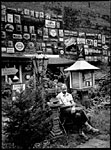 The
photography of everyday life, showing the gradual collapse of personal,
social, and political stability in East Germany, is the true subject
of this book and exhibition. Nowhere is this collapse more evident
than in the ever-changing editorial mandates, the diatribes against
bourgeois photography, the infrequent bold excursions into uncharted
ground, and the progressively critical images presented in Die
Fotografie. And nowhere is the failure of its socialist aesthetic
more evident than in Die Fotografie's editorial refusal to
acknowledge the fall of East Germany in 1989.
The
photography of everyday life, showing the gradual collapse of personal,
social, and political stability in East Germany, is the true subject
of this book and exhibition. Nowhere is this collapse more evident
than in the ever-changing editorial mandates, the diatribes against
bourgeois photography, the infrequent bold excursions into uncharted
ground, and the progressively critical images presented in Die
Fotografie. And nowhere is the failure of its socialist aesthetic
more evident than in Die Fotografie's editorial refusal to
acknowledge the fall of East Germany in 1989.  Images
of the dismantling of the Berlin Wall and the demonstrations that
preceded it do not appear in the periodical until 1990, a full year
or more after they occurred. In its failure to recognize this most
spectacular event through the photography of everyday life, Die
Fotografie lost its opportunity to stay relevant to East Germans
living and working in a fundamentally altered world. The final issue
of Die Fotografie was printed in March 1991.
Images
of the dismantling of the Berlin Wall and the demonstrations that
preceded it do not appear in the periodical until 1990, a full year
or more after they occurred. In its failure to recognize this most
spectacular event through the photography of everyday life, Die
Fotografie lost its opportunity to stay relevant to East Germans
living and working in a fundamentally altered world. The final issue
of Die Fotografie was printed in March 1991.
A
small sampling of articles, most written during the 1960s, is presented
here more or less in their original format, as seen in the pages of
Die Fotografie. All of these articles were written by representatives
of the ZKF, and all were selected for the clarity of the imperatives
they describe. However, it should be noted that in addition to such
politically oriented texts Die Fotografie regularly published
one-person portfolios, group portfolios (frequently by worker's brigades,
but more often than not describing a particular theme or issue), instructional
articles on scientific and "leisure" photography (animals,
nature, travel, etc.), articles by curators, letters to the editor
(including a popular forum for readers to respond to images), and
much more.

 The
photography of everyday life, showing the gradual collapse of personal,
social, and political stability in East Germany, is the true subject
of this book and exhibition. Nowhere is this collapse more evident
than in the ever-changing editorial mandates, the diatribes against
bourgeois photography, the infrequent bold excursions into uncharted
ground, and the progressively critical images presented in Die
Fotografie. And nowhere is the failure of its socialist aesthetic
more evident than in Die Fotografie's editorial refusal to
acknowledge the fall of East Germany in 1989.
The
photography of everyday life, showing the gradual collapse of personal,
social, and political stability in East Germany, is the true subject
of this book and exhibition. Nowhere is this collapse more evident
than in the ever-changing editorial mandates, the diatribes against
bourgeois photography, the infrequent bold excursions into uncharted
ground, and the progressively critical images presented in Die
Fotografie. And nowhere is the failure of its socialist aesthetic
more evident than in Die Fotografie's editorial refusal to
acknowledge the fall of East Germany in 1989.  Images
of the dismantling of the Berlin Wall and the demonstrations that
preceded it do not appear in the periodical until 1990, a full year
or more after they occurred. In its failure to recognize this most
spectacular event through the photography of everyday life, Die
Fotografie lost its opportunity to stay relevant to East Germans
living and working in a fundamentally altered world. The final issue
of Die Fotografie was printed in March 1991.
Images
of the dismantling of the Berlin Wall and the demonstrations that
preceded it do not appear in the periodical until 1990, a full year
or more after they occurred. In its failure to recognize this most
spectacular event through the photography of everyday life, Die
Fotografie lost its opportunity to stay relevant to East Germans
living and working in a fundamentally altered world. The final issue
of Die Fotografie was printed in March 1991.